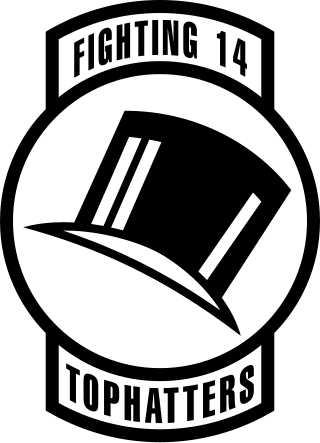
The Strike Fighter Squadron 14 (VFA-14) "Tophatters" are a United States Navy fighter attack squadron based at Naval Air Station Lemoore. They fly the F/A-18E Super Hornet, and are the Navy's oldest active squadron, having formed in 1919. Their callsign is Camelot, and their tail code is NG.

VFA-31 or Strike Fighter Squadron 31 is known as the Tomcatters, callsign "Felix", a United States Navy strike fighter squadron stationed at Naval Air Station Oceana flying the F/A-18E Super Hornet. The Tomcatters are the second oldest Navy Fighter Attack squadron operating today.

Strike Fighter Squadron 213 (VFA-213) Blacklions is an aviation unit of the United States Navy based at Naval Air Station Oceana, Virginia. It was established in 1955 and is currently equipped with the F/A-18F Super Hornet. The squadron is assigned to Carrier Air Wing Eight and uses the radio callsign Lion.

Strike Fighter Squadron 102 (VFA-102) is a United States Navy Strike Fighter squadron based at Marine Corps Air Station Iwakuni. Their call sign is Diamond, with the tail code NF, and they fly the F/A-18F Super Hornet.

Strike Fighter Squadron 41 (VFA-41) also known as the "Black Aces", is a United States Navy strike fighter squadron based at Naval Air Station Lemoore, California, flying the F/A-18F Super Hornet. They are attached to Carrier Air Wing 9 (CVW-9). Their radio callsign is "Fast Eagle" and their tailcode is NG.

Strike Fighter Squadron 32 (VFA-32), nicknamed the "Fighting Swordsmen" are a United States Navy strike fighter squadron presently flying the F/A-18F Super Hornet and based ashore at Naval Air Station Oceana. Their radio callsign is Gypsy and their tail code is AC. The Fighting Swordsmen of VFA-32 are the 2023 recipients of the Mutha Fighter Spirit Award, awarded annually at the Navy’s Strike Fighter Ball in Norfolk, VA.
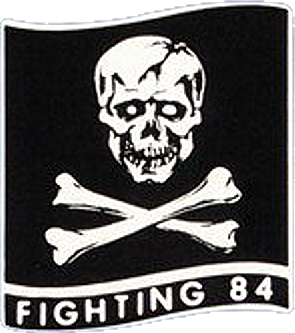
VF-84, Fighter Squadron 84 was an aviation unit of the United States Navy. Originally established as VA-86 on 1 July 1955, it was immediately redesignated as VF-84 and was disestablished on 1 October 1995. It was the third US Navy squadron to be designated as VF-84. The squadron was nicknamed the Jolly Rogers and was based at NAS Oceana. It took the number but not the lineage of VF-84 the "Wolf Gang" and the insignia of VF-61 the Jolly Rogers.

Strike Fighter Squadron 103 (VFA-103), nicknamed the Jolly Rogers, is an aviation unit of the United States Navy established in 1952. VFA-103 flies the F/A-18F Super Hornet and is based at Naval Air Station Oceana, Virginia (US). The squadron's radio callsign is Victory and it is assigned to Carrier Air Wing Seven.

Strike Fighter Squadron 2 (VFA-2) also known as the "Bounty Hunters" is a United States Navy F/A-18F Super Hornet strike fighter squadron based at Naval Air Station Lemoore, California. Their tail code is NE and their callsign is "Bullet". They are attached to Carrier Air Wing 2 (CVW-2), a composite unit made up of a wide array of aircraft performing a variety of combat and support missions that deploy aboard the Carl Vinson.

Strike Fighter Squadron 11 (VFA-11) is a United States Navy strike fighter squadron stationed at Naval Air Station Oceana, Virginia, United States. The squadron was established in 1950 and is nicknamed "Red Rippers". VFA-11 is equipped with the Boeing F/A-18F Super Hornet and currently assigned to Carrier Air Wing One.

Fighter Squadron 21 (VF-21) Freelancers was an aviation unit of the United States Navy. Originally established in 1944 as VF-81 it was redesignated VF-13A in 1946, redesignated VF-131 in 1948, redesignated VF-64 in 1950 and redesignated VF-21 on 1 July 1959, it was disestablished on 31 January 1996. It was the third US Navy squadron to have the VF-21 designation.
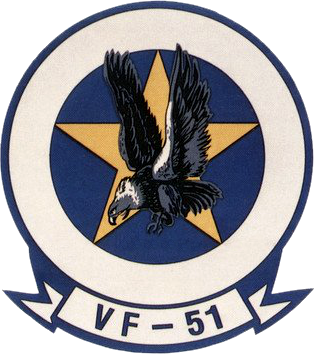
VF-51, Fighter Squadron 51 was an aviation unit of the United States Navy known as the "Screaming Eagles". It was originally established as VF-1 on February 1, 1943, redesignated as VF-5 on July 15, 1943, redesignated as VF-5A on November 15, 1946, redesignated VF-51 on August 16, 1948, and disestablished in March 1995. Until its disestablishment, VF-51 was the oldest fighter squadron in continuous service with the Pacific Fleet.

VF-74, Fighter Squadron 74, Be-Devilers was an aviation unit of the United States Navy in service from 1944 to 1994. Originally established as VBF-20 on 16 April 1945, it was redesignated as VF-10A on 15 November 1946, redesignated as VF-92 on 12 August 1948, redesignated as VF-74 on 15 January 1950 and disestablished on 30 April 1994. It was the third US Navy squadron to be designated as VF-74.

Fighter Squadron 114 (VF-114) was a fighter squadron of the United States Navy that was active from 1945 through 1993. Nicknamed the "Aardvarks", it was based out of Naval Air Station Miramar, California. The squadron flew combat missions during the Korean War and Vietnam War. VF-114 was disestablished as part of the post-Cold War drawdown of forces on April 30, 1993.
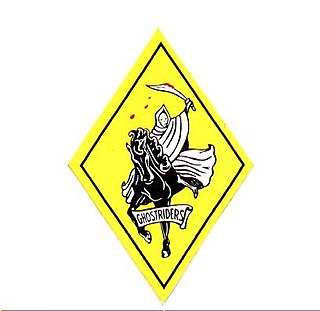
VF-142 Ghostriders was a US Navy fighter squadron established on 24 August 1948 as VF-193, it was redesignated VF-142 on 15 October 1963, and disestablished on 30 April 1995.

Strike Fighter Squadron 154 (VFA-154), also known as the "Black Knights", is a United States Navy strike fighter squadron stationed at Naval Air Station Lemoore. The Black Knights are an operational fleet squadron flying the F/A-18F Super Hornet. They are currently attached to Carrier Air Wing Eleven and deployed aboard the aircraft carrier USS Theodore Roosevelt. Their tailcode is NH and their callsign is "Knight".
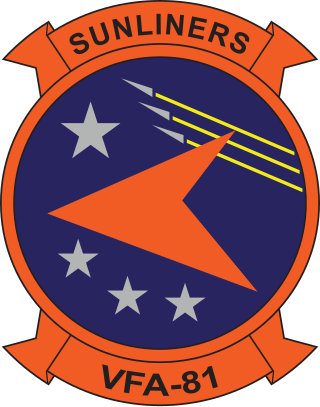
Strike Fighter Squadron 81 (VFA-81), also known as the "Sunliners", is a United States Navy F/A-18E Super Hornet strike fighter squadron stationed at Naval Air Station Oceana. They are currently assigned to Carrier Air Wing 1. Their mission is to conduct prompt and sustained combat operations from the sea. The squadron was originally designated VA-66 on 1 July 1955, was redesignated VF-81 the same day, redesignated VA-81 on 1 July 1959, and finally redesignated VFA-81 on 4 February 1988.

Strike Fighter Squadron 83 (VFA-83), also known as the "Rampagers", are a United States Navy F/A-18E Super Hornet fighter squadron stationed at Naval Air Station Oceana. They are a part of Carrier Air Wing 3, their tailcode is AC and their radio callsign is Ram.

Carrier Air Wing Eight (CVW-8), is a United States Navy aircraft carrier air wing based at Naval Air Station Oceana, Virginia. The air wing is attached to the aircraft carrier USS Gerald R. Ford (CVN-78)

Carrier Air Wing Seventeen (CVW-17), is a United States Navy aircraft carrier air wing based at Naval Air Station Lemoore, California. The air wing is attached to the aircraft carrier USS Nimitz.





























